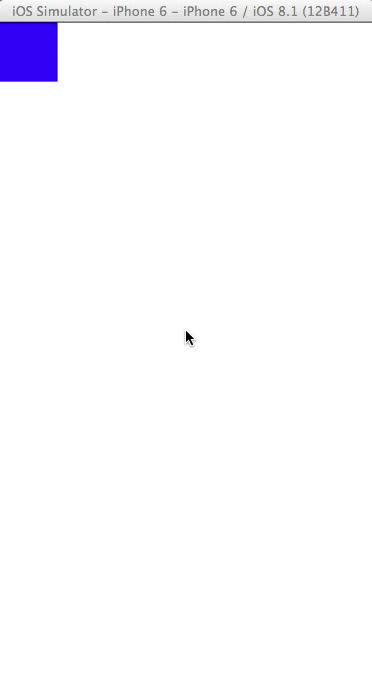# Titanium.UI.iOS.SnapBehavior
Dynamic behavior defining an item's movement to a specific point.
# Overview
A snap behavior specifies how an item moves towards a specified point with a spring-like effect, ending with an oscillation.
- Use the Titanium.UI.iOS.createSnapBehavior method to create the behavior.
- Set the Titanium.UI.iOS.SnapBehavior.item and Titanium.UI.iOS.SnapBehavior.snapPoint properties.
- Add the behavior to an Titanium.UI.iOS.Animator.
# Examples
# Simple Example
The following example snaps the block to the location of a click on the window.

var win = Ti.UI.createWindow({backgroundColor: 'white', fullscreen: true});
// Create an Animator object using the window as the coordinate system
var animator = Ti.UI.iOS.createAnimator({referenceView: win});
var block = Ti.UI.createView({
width: 100,
height: 100,
backgroundColor: 'blue'
});
// Snap to the top-left corner when the app starts
var snap = Ti.UI.iOS.createSnapBehavior({
item: block,
snapPoint: {x: 0, y: 0},
});
animator.addBehavior(snap);
// Snap the block to the point of the click event
win.addEventListener('click', function(e){
snap.snapPoint = {x: e.x, y: e.y};
snap.damping = Math.random();
});
// Start the animation when the window opens
win.addEventListener('open', function(e){
animator.startAnimator();
});
win.add(block);
win.open();
# Properties
# apiName READONLY
The name of the API that this proxy corresponds to.
The value of this property is the fully qualified name of the API. For example, Titanium.UI.Button
returns Ti.UI.Button.
# bubbleParent
Indicates if the proxy will bubble an event to its parent.
Some proxies (most commonly views) have a relationship to other proxies, often established by the add() method. For example, for a button added to a window, a click event on the button would bubble up to the window. Other common parents are table sections to their rows, table views to their sections, and scrollable views to their views. Set this property to false to disable the bubbling to the proxy's parent.
Default: true
# damping
Specifies the amount of oscillation during the conclusion of the snap.
A value of 0.0 indicates minimum oscillation, while 1.0 indicates maximum oscillation.
Default: 0.5
# Methods
# addEventListener
Adds the specified callback as an event listener for the named event.
Parameters
| Name | Type | Description |
|---|---|---|
name | String | Name of the event. |
callback | Callback<Titanium.Event> | Callback function to invoke when the event is fired. |
Returns
- Type
- void
# applyProperties
Applies the properties to the proxy.
Properties are supplied as a dictionary. Each key-value pair in the object is applied to the proxy such that myproxy[key] = value.
Parameters
| Name | Type | Description |
|---|---|---|
props | Dictionary | A dictionary of properties to apply. |
Returns
- Type
- void
# fireEvent
Fires a synthesized event to any registered listeners.
Parameters
| Name | Type | Description |
|---|---|---|
name | String | Name of the event. |
event | Dictionary | A dictionary of keys and values to add to the Titanium.Event object sent to the listeners. |
Returns
- Type
- void
# removeEventListener
Removes the specified callback as an event listener for the named event.
Multiple listeners can be registered for the same event, so the
callback parameter is used to determine which listener to remove.
When adding a listener, you must save a reference to the callback function in order to remove the listener later:
var listener = function() { Ti.API.info("Event listener called."); }
window.addEventListener('click', listener);
To remove the listener, pass in a reference to the callback function:
window.removeEventListener('click', listener);
Parameters
| Name | Type | Description |
|---|---|---|
name | String | Name of the event. |
callback | Callback<Titanium.Event> | Callback function to remove. Must be the same function passed to |
Returns
- Type
- void
